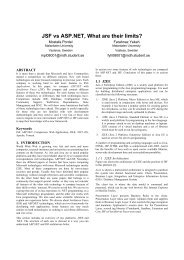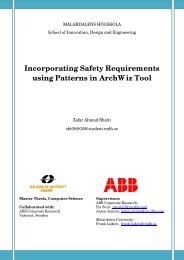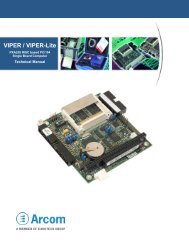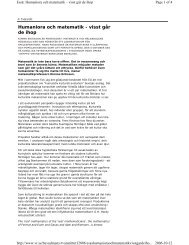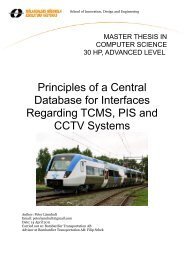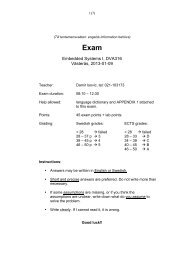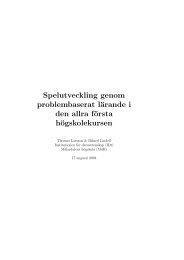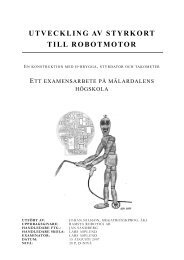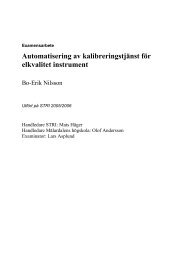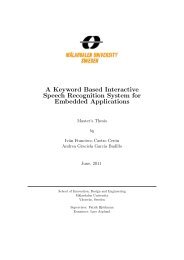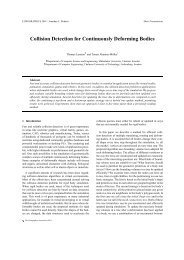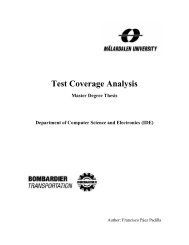CoDeSys on CCP XS for Bromma Conquip - Research
CoDeSys on CCP XS for Bromma Conquip - Research
CoDeSys on CCP XS for Bromma Conquip - Research
- No tags were found...
You also want an ePaper? Increase the reach of your titles
YUMPU automatically turns print PDFs into web optimized ePapers that Google loves.
Student<br />
Joel Ek<br />
Supervisor at CC-Systems<br />
Fredrik Löwenhielm<br />
Dok Nr<br />
1.0<br />
Date<br />
2006-08-08<br />
Rev<br />
PA1<br />
Säk klass<br />
F<br />
Filname<br />
Thesis.doc<br />
CODESYS ON <strong>CCP</strong> <strong>XS</strong> FOR BROMMA CONQUIP<br />
2.2 <str<strong>on</strong>g>CoDeSys</str<strong>on</strong>g><br />
C<strong>on</strong>trolled Developed System (<str<strong>on</strong>g>CoDeSys</str<strong>on</strong>g>) is developed by Smart Software Soluti<strong>on</strong>s (3S) and<br />
they describe their software as a complete development envir<strong>on</strong>ment <strong>for</strong> your PLC.<br />
<str<strong>on</strong>g>CoDeSys</str<strong>on</strong>g> implements the standard IEC 61131-3 and 3S is today <strong>on</strong>e the leading manufacture in<br />
programming PLC systems.<br />
2.2.1 The IEC 61131 standard<br />
The IEC 61131-3 standard is a standard <strong>for</strong> programming languages that is used in industrial<br />
automati<strong>on</strong>, typically to program a PLC. The standard c<strong>on</strong>sists of two parts: Comm<strong>on</strong> objects<br />
and Programming languages [17, 18].<br />
2.2.1.1 Comm<strong>on</strong> objects<br />
The comm<strong>on</strong> elements define which data types that must exist, how the variables should be<br />
declared (input, output and global etc). It also defines that a PLC program is to be build using<br />
Programming Organising Units (POU), these POUs are: Program, Functi<strong>on</strong> Block and Functi<strong>on</strong>.<br />
2.2.1.2 Programming languages<br />
The other part defines which languages that should exist in order to follow the standard. They<br />
are: Instructi<strong>on</strong> list, Structured Text, Functi<strong>on</strong> Block Diagram, Ladder Diagram and Sequence<br />
Functi<strong>on</strong> Chart.<br />
2.2.2 Languages<br />
<str<strong>on</strong>g>CoDeSys</str<strong>on</strong>g> support all the standard languages defined <strong>for</strong> PLC programming and implements <strong>on</strong>e<br />
more, the C<strong>on</strong>tinues functi<strong>on</strong> chart.<br />
Descripti<strong>on</strong> of the different language in <str<strong>on</strong>g>CoDeSys</str<strong>on</strong>g>:<br />
- Instructi<strong>on</strong> List (IL) is a text based language similar to assembler language.<br />
- Structured Text (ST) is a text based higher layer programming language.<br />
- Functi<strong>on</strong> Block Diagram (FBD) allow the user to graphically c<strong>on</strong>nect different functi<strong>on</strong><br />
blocks, both standardized functi<strong>on</strong>s like AND but also own user defined. And in that way<br />
create a more complex functi<strong>on</strong>.<br />
- Ladder Diagram (LD) is the corresp<strong>on</strong>dence to ladder logic in the IEC 61131-3 standard<br />
and is a graphical language to c<strong>on</strong>nect relay and coil.<br />
- Sequential Functi<strong>on</strong> Chart (SFC) is used <strong>for</strong> programs that can be divided into step, each<br />
step c<strong>on</strong>tains some acti<strong>on</strong> and the transiti<strong>on</strong> to the next step is c<strong>on</strong>trolled by a logic<br />
c<strong>on</strong>diti<strong>on</strong>.<br />
- C<strong>on</strong>tinues Functi<strong>on</strong> Chart (CFC) is similar to FBD, not as fast but more flexible, allowing<br />
both c<strong>on</strong>tinuous c<strong>on</strong>necti<strong>on</strong>s and change of executi<strong>on</strong> order.<br />
16 (55)



